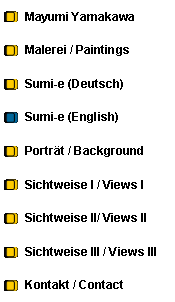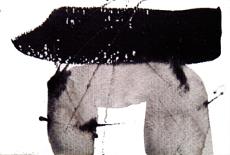
|
Sumi Art (Selection) : Sumi-e (Japanese ink wash painting) |


|
Sumi-e – reducing little to even less (→ Deutsch)
Sumi is the Japanese form of a Far Eastern art style and painting technique whose roots date back to the Tang Dynasty in China some 1,300 years ago. Further refined there between the 10th and 13th centuries, this style of ink wash painting made its way via Korea to Japan some 500 years ago, where it was developed during the period of the Kitayma culture into a form that has been handed down to today. During this period of a sophisticated intellectual and art world the typical Japanese arts of the Noh theatre, tea ceremony and garden landscaping also emerged, remaining unchanged since then.
From ink block to ink
"Ink" in this context is the always black ink that is also used in Far Eastern calligraphy, made from spruce soot and animal glue – the latter extracted from stag antlers or bovine bones as a binder – and made into small elongated blocks.
Culturally and spiritually sumi-e is rooted in the spirit of Zen, the Japanese expression of Buddhism. The core aspect is curtailment and detachment from the world as an antithesis to the joys of daily life. Accordingly Sumi-e paintings are reduced in form, whether figurative or abstract, and in color, with only black and gray shades applied.
Sumi-e must flow
Her method of working requires a high degree of concentration and mastery of the technique since each brush stroke on the paper is permanent and cannot be corrected: the brush must flow over the paper continuously without interruption, within seconds rather than minutes. If this is unsuccessful or less than satisfactory, the work is "dead" because it lacks the right spirit. Therefore many hours are usually required until, after several dozen attempts and sheets of paper, a single sumi-e work remains – if any at all – that meets her artistic aspirations. |


|
Dr. Bärbel Schäfer,
Origin and Present Age,
Already from her own origin Mayumi Yamakawa succeeds to implement the exhibition theme with a light touch. She chooses the ancient art of calligraphy and Sumi-e to make modern statements. The contemporary appearance does not contradict the his-torical tradition.
Unity of body and mind, in Süddeutsche Zeitung
The flow starts when sense, thought and action are in complete congruence. Neither time nor distracting thoughts are present. The activity happens effortless – it flows. Looking at her dyna-mic calligraphies it is obvious that Mayumi Yamakawa is in a state of unity of body and mind when she paints...In addition to calligraphy she presents ink wash paintings, reverting to a centuries-old Japanese painting technique. Nonetheless, these images look very modern. |


|
My Rakkan (Artist‘s signature) sealed on my work that is read „Sokyu“: Hemispheric blue skay over 10,000 m high. |

|
Private collections, Germany and UK |
|
„Twin“ Collection of an interior designer's office, Boston |
|
Dr. Jutta Mannes, art historian and curator, works at the Association of Galleries and Museums Dachau, Germany
(Mayumi Yamakawa‘s) large calligraphy murals are composed as traditional Japanese scroll paintings. The titles suggest that they are filled with thoughts of water, air and wind. They do not intend to represent or explicate anything but just give some hints...Despite the strong reduction, which she seeks in her paintings, or perhaps even because of it, I think that these images are very dynamic and tremendously energetic.
|
|
New |
